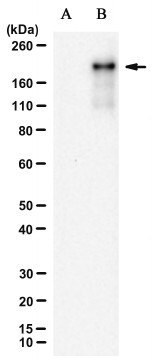MABF3083
Anti-SARS-CoV-2 Delta Spike Antibody, P681R Antibody, clone 4C5-B2
Synonim(y):
S glycoprotein Delta P681R, Spike glycoprotein Delta P681R
About This Item
Polecane produkty
pochodzenie biologiczne
mouse
Poziom jakości
forma przeciwciała
purified antibody
rodzaj przeciwciała
primary antibodies
klon
4C5-B2, monoclonal
masa cząsteczkowa
calculated mol wt 141.18 kDa
observed mol wt ~200 kDa
oczyszczone przez
using protein G
reaktywność gatunkowa
virus
opakowanie
antibody small pack of 100 μL
metody
western blot: suitable
izotyp
IgG2aκ
sekwencja epitopowa
Extracellular domain
numer dostępu UniProt
temp. przechowywania
2-8°C
informacje o genach
vaccinia virus ... S(43740568)
Specyficzność
Immunogen
Zastosowanie
Evaluated by Western Blotting in lysate from HEK293T cells transiently transfected with SARS-CoV-2 Delta spike B.1.617.2.
Western Blotting Analysis: A 1:500 dilution of this antibody detected SARS-CoV-2 Delta spike protein (P681R) in lysate from HEK293T cells transiently transfected with SARS-CoV-2 Delta spike B.1.617.2, but not in wild-type HEL293T cells.
Tested Applications
Western Blotting Analysis: A representative lot detected SARS-CoV-2 Delta spike protein (P681R) in Various whole cell lysates of HEK293T SARS-CoV-2 spike transfectants (Data courtesy of Dr. Stefan Schüchner and Dr. Egon Ogris (Max Perutz Labs, Medical University of Vienna, Austria).
Note: Actual optimal working dilutions must be determined by end user as specimens, and experimental conditions may vary with the end user.
Opis wartości docelowych
Postać fizyczna
Rekonstytucja
Przechowywanie i stabilność
Inne uwagi
Oświadczenie o zrzeczeniu się odpowiedzialności
Not finding the right product?
Try our Narzędzie selektora produktów.
Kod klasy składowania
12 - Non Combustible Liquids
Klasa zagrożenia wodnego (WGK)
WGK 1
Temperatura zapłonu (°F)
Not applicable
Temperatura zapłonu (°C)
Not applicable
Certyfikaty analizy (CoA)
Poszukaj Certyfikaty analizy (CoA), wpisując numer partii/serii produktów. Numery serii i partii można znaleźć na etykiecie produktu po słowach „seria” lub „partia”.
Masz już ten produkt?
Dokumenty związane z niedawno zakupionymi produktami zostały zamieszczone w Bibliotece dokumentów.
Nasz zespół naukowców ma doświadczenie we wszystkich obszarach badań, w tym w naukach przyrodniczych, materiałoznawstwie, syntezie chemicznej, chromatografii, analityce i wielu innych dziedzinach.
Skontaktuj się z zespołem ds. pomocy technicznej






